Ofcom is the UK’s communications regulator, and Steve Under is the body’s CTO. He took the opportunity to talk about standards, questioning which is more important: standardisation or differentiation. Standards are very important, as they can bring interoperability and economies of scale. Innovation, however, is driven by competition, so standardisation must leave room for this.
Change is ‘the new normal’, and its pace is accelerating. In the last decade, the UK’s TV industry has added digital, HD, IPTV and UltraHD services. By contrast there were 30 – 40 years between the UK’s first black and white and colour broadcast. It took nine years for UltraHD services to begin to be offered after HD had launched, but only three years for Netflix to go from zero to four million UK subscribers.
Despite these changes, linear (DTT) TV remains important, especially for older and less well-off consumers. The growth in VoD has been largely complementary to existing platforms, although both linear and on-demand IPTV are growing, Ofcom’s data shows.
Young people are increasingly watching TV online. This is not wholly new, but in the past they tended to “revert to type” and watch more linear TV as they got older. Ofcom is now noticing that as people age they are bringing their viewing habits with them.
IPTV is creating new opportunities for innovation in TV – but also creates some risks for consumers. The benefits of differentiation include faster innovation and new approaches to delivery and navigation. However, with collaboration systems tend to become simpler, more consistent and offer greater interoperability between receivers and services. Collaborating while also celebrating differences is delivering a wide range of benefits, said Under.
Concluding, Under named two challenges. First, how does the industry move to more efficient transport methods, which are necessary for UltraHD? Second, how do we prevent consumers buying so-called ‘4k-ready’ TVs that will be obsolete in two years?
In a Q&A session, Hewlett posed the same question to Under – how could you stop consumers buying these early UltraHD TVs, which are unlikely to support any future standards? Under favoured the idea of a ‘kite mark’ or logo, which the industry agrees will go onto these screens. If that doesn’t happen, then a regulatory response may be needed, but Under would prefer a collaborative solution. Ofcom will work with the industry, rather than shepherding it. He also said that there could be an Ofcom conference to discuss standards.
A member of the audience from Samsung asked if Under was aware that Digitaleurope already has a logo for UltraHD TVs (Display.Monitor Vol 21 No 35). Under replied that there are many logos (this is true – the EBU also has one for broadcasters and the CEA for TV vendors in the USA – TA), but no guarantee that the specifications will be relevant in a few years’ time. The questioner pointed out that hardware manufacturers have agreed standards with Digitaleurope, but cannot guarantee that broadcasters will stick to them. Hewlett asked if the vendors had talked to broadcasters, getting a laugh; the audience member said that, as far as he was aware, no broadcasters have signed up to the logo yet.
Analyst Comment
As we mentioned last week in our report on the SES Industry Days, the Digitaleurope logo is really seen as an interoperability logo. However, a new box may need to be added to the set for full compatibility with future standards. That could cause trouble for consumers and for brands in dispute with consumers later. (BR)

